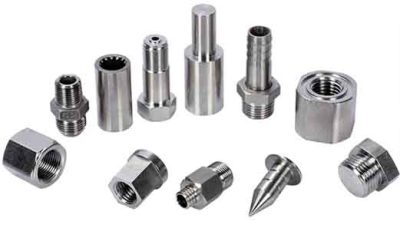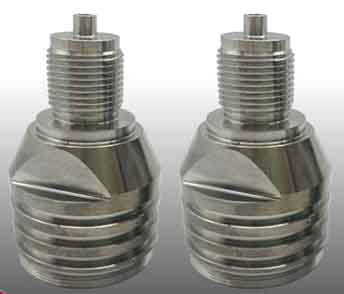Problemi di tornitura CNC di filetti di acciaio inossidabile e contromisure
La rugosità superficiale della filettatura di tornitura CNC è troppo scarsa. Il fenomeno più comune riscontrato nella tornitura CNC di filetti in acciaio inossidabile è: increspature simili a scaglie e fenomeno dei morsi di coltello. Le ragioni di questi fenomeni sono:
(1) The clearance angles of the two sides of the thread turning tool are too small, and the friction between the two sides of the cutting tool and the rear thread surface will deteriorate the machined surface. The influence of the thread rotation angle on the actual clearance angle of both edges must be considered during processing.
(2) The rake angle of the thread turning tool is too small and the cutting edge is not sharp enough. The chips cannot be cut smoothly, but are partially squeezed or torn off, which must cause the thread surface to be very rough. When the front angle is too large, the strength of the blade is weakened and it is easy to wear, chip, and pierce the knife, which is more likely to cause vibration and cause ripples on the thread surface. Perciò, l'angolo di spoglia appropriato deve essere selezionato in base ai diversi materiali dell'acciaio inossidabile. Quando si girano filetti di acciaio inossidabile resistenti all'acido solforico concentrato, è necessario utilizzare un angolo di spoglia inferiore rispetto alla tornitura di filettature in acciaio inossidabile 2Cr13. I taglienti su entrambi i lati dell'utensile di tornitura devono avere taglienti molto stretti per evitare una rapida usura dei taglienti. Quando si taglia 2Cr13, 1Cr17, 4Cr13, il tagliente dovrebbe essere il più affilato possibile, in caso contrario non sarà facile ottenere la buona rugosità superficiale richiesta.

Processo di tornitura del filo di acciaio inossidabile
(3) la lama del tagliafilo è smussata, Infatti, l'angolo di spoglia, angolo di rilievo da grande a piccolo, i trucioli schiacciati nel severo processo di formatura, in modo che la forza di taglio aumenti durante l'aumento delle vibrazioni di taglio, grave deterioramento della superficie lavorata. Perciò, when turning stainless steel threads, the blade must be kept sharp at all times and the cutter head must be replaced in time.
(4) Insufficient fixation of threaded turning tools, excessively extended tool heads, insufficient tool arbor rigidity, poor machine tool accuracy, loose spindles, loose tool holders and other factors can cause vibration and cause ripples on the threaded surface. Perciò, you must pay attention to the operation of the machine tool, cutting tool and workpiece during operation to make the system sufficiently rigid. When installing the turning tool, in addition to ensuring a firm installation and no looseness, the tip of the turning tool should be slightly higher than the center of the workpiece by 0.2-0.5mm, and never lower than the center to avoid cutting the tool.
(5) Avoid using the straight forward method when turning stainless steel threads. Due to the long chip contact length on the left and right sides, it is prone to vibration, which increases the load on the tool tip, causes vibration and increases the resistance during chip removal, and scratches the surface of the workpiece. Perciò, for the processing of stainless steel threads, it is best to choose the method of cross-turning threads. This method adopts the alternate lateral feed method, especially for the cutting of large-pitch threads and viscous materials. It is the most effective measure to solve the vibration problem. Since the cutting edges are used crosswise, the wear is even and the tool life can be prolonged.
(6) The matching degree of the cutting amount in the process of CNC cutting stainless steel threads directly affects the processing efficiency. If the cutting amount is too small, the tool wear will be aggravated, and if it is too large, the tool will collapse. Perciò, the number of cuts and the feed per cut will have a decisive influence on the thread turning. In order to obtain the best tool life, the workpiece diameter should not be larger than the major thread diameter 0.14mm, and the feed per tool less than 0.05mm should be avoided. The total cutting amount for machining should be set at about 0.1mm, the first cut depth should be 150-200% of the nose radius (R), and the maximum should not exceed 0.5mm. For austenitic stainless steel, a feed per cut of less than 0.08mm should be avoided. Common edge inserts with a small nose radius for internal threads may increase the number of cuts as the depth of the tool decreases. Thread size is unstable after CNC turning stainless steel. After thread processing. Use a thread ring gauge to measure that the “through end” of the external thread cannot be entered, or there are phenomena such as inconsistencies in the front and rear tightness and partial passage of the “stop end”.

Cooling lubricant for turning stainless steel thread
Reasons for these ills of thread:
(1) The thread profile is wrong. Even if the pitch diameter of the thread has reached the specified size, the thread ring gauge and plug gauge may still not be screwed.
(2) The thread is inverted. When measuring with a thread gauge, there is often a phenomenon that is restricted by the directionality. That is to say, it is tightened from one end and loosened from the other end, and even the phenomenon that the “through end” cannot pass but the “stop end” passes instead.
(3) If the bottom diameter of the internal thread is too small, or the bottom diameter of the external thread is too large, the thread gauge will not be screwed in. This is because the turning tool wears and becomes dull, and there is extrusion during the cutting process, which makes the outer diameter or inner diameter of the thread squeeze out of burrs.
(4) When turning internal threads with a small diameter, the rigidity of the turning tool bar is limited by the size. During the turning process, it is easy to produce “give a knife”, and even the local size is large, which causes the local tolerance to be out of tolerance.
(5) When turning the stainless steel slender screw, due to the poor rigidity of the workpiece, deformation occurs during the turning process, resulting in dimensional errors on the thread.
(6) When turning the internal and external threads of stainless steel thin-walled workpieces, the workpiece will be locally deformed due to the force and cutting temperature, and the thread will also be locally out of tolerance. Perciò, in order to solve the problem of “the thread gauge cannot enter”, corresponding measures must be taken for the above reasons, mainly from the aspects of correct installation and proper clamping of the workpiece.
The subtle role of cooling lubricating fluid in CNC thread cutting
L'uso ragionevole del fluido lubrificante può migliorare le condizioni di taglio e ottenere un effetto moltiplicatore. È necessario prestare attenzione quando si tagliano i fili di acciaio inossidabile con CNC:
Requisiti speciali per i lubrificanti refrigeranti:
(1) A causa della tenacità dell'acciaio inossidabile e della difficoltà di separarlo mediante taglio, il liquido refrigerante deve avere prestazioni di raffreddamento più elevate per eliminare molto calore.
(2) A causa dell'elevata viscosità e dell'elevata proprietà di fusione, è facile produrre bordo di riporto durante il taglio del filo, quindi il liquido refrigerante dovrebbe avere elevate prestazioni lubrificanti.
(3) Il liquido refrigerante deve avere una buona permeabilità, che possono penetrare nelle sottili linee della zona metallica durante il taglio, in modo che i trucioli si rompano facilmente.
(4) Deve avere una certa funzione di lavaggio.
Utilizzare diversi refrigeranti adatti
(1) L'olio vulcanizzato ha buone prestazioni di raffreddamento e prestazioni di lubrificazione, e possono essere suddivisi in diretti e indiretti a seconda delle diverse modalità di preparazione. La formula dell'olio fluidificato diretto è 98% olio minerale e 2% zolfo. La formula dell'olio solforato indiretto è: olio minerale 78%-80%, olio motore nero, olio vegetale 18%-20%, e zolfo 1.7%.
(2) L'olio F43 è adatto per raffreddare e lubrificare il taglio dell'acciaio inossidabile, e ha l'effetto migliore sui fili di acciaio inossidabile. La formula è: NO. 5 olio per motori ad alta velocità 83.5%, solfonato di petrolio di calcio 4%, fosfato di bario e petrolio 4%, sapone di bario grasso di petrolio ossidato 4%, dialchiltiofosfato di zinco 4%, e disolfuro 0.5%.
(3) Olio vegetale, come l'olio di soia, aiuta a ottenere una migliore ruvidità della superficie della filettatura e a prolungare la durata dell'utensile durante la tornitura delle filettature.
In sintesi, se si tratta di acciaio inossidabile martensitico, acciaio inossidabile ferritico o acciaio inossidabile austenitico, o addirittura austenitico + acciaio inossidabile ferritico, i metodi di lavorazione del filo corrispondenti dovrebbero essere sviluppati in base alle diverse strutture metallografiche . Al fine di ottenere l'effetto di elaborazione ideale, creare maggiori benefici economici e sociali.
 English
English العربية
العربية 中文(漢字)
中文(漢字) Čeština
Čeština Dansk
Dansk Nederlands
Nederlands Suomi
Suomi Français
Français Deutsch
Deutsch Italiano
Italiano 日本語
日本語 ಕನ್ನಡ
ಕನ್ನಡ 한국어
한국어 Português
Português Русский
Русский Slovenčina
Slovenčina Español
Español Svenska
Svenska Türkçe
Türkçe

